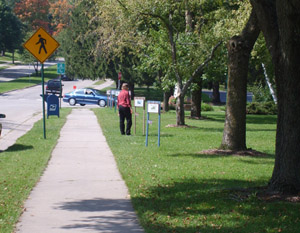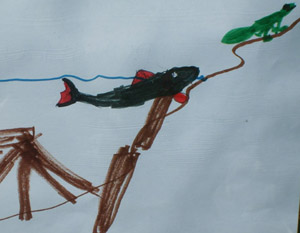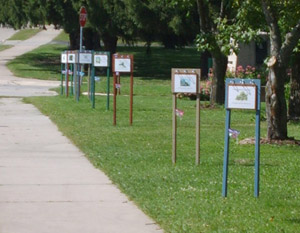A recurring theme for science educators is how to make the vastness of the history and diversity of life "real" for students. In their classrooms, they devise clock models, modified calendars, and even use 1000-sheet rolls of toilet tissue to emphasize the deep history of life on earth and the variety (and success) of the many forms of life that have appeared during that time.

A park visitor stops to consider Station 6: Reptiles Become Dominant, 270 mya, as viewed from Station 5: Plants and Amphibians Come onto Land, 400 mya.In the fall of 2007, artist J Nicholas Schweitzer set up an installation in a public park in Madison, Wisconsin. The installation consisted of fifteen signposts depicting significant events in the history of life with illustrations of life forms that emerged and flourished in association with certain "milestones" — for example, the emergence of the first plants and animals onto land or the first appearance of primates. In addition, the stations are spaced in such a way so that the distance between them is in proportion to the amount of time that passed between the milestones. So, for example, the distance representing the one billion years from the formation of the earth to the first record of unicellular life is about half as long as the distance between the first unicellular life and the diversification of multicellular organisms almost two billion years later in the late Precambrian.

Rendition of Station 5: Plants and Amphibians Come onto Land, 400 mya, by a student at Van Hise Elementary School, Madison, WI. For those familiar with the exhibit "A Walk Through Time" created in the 1990s at Hewlett Packard by Sidney Liebes and his colleagues (Liebes and others 1998), Schweitzer's installation recalls the value in adding the "kinesthetic" dimension to the learning experience. It is almost as though having to travel in space and take time to reach the next milestone in the history of life imparts a deeper appreciation for the length of time between events.
Although the "Walk Through Time" exhibit was about twice as long — extending for about a mile — it consisted largely of displays to view and read. Schweitzer's exhibit added two significant dimensions to the approach that Liebes and colleagues pioneered. First, each station contains both a cover page created by the artist and several illustrations composed by students at Van Hise Elementary and Velma Hamilton Middle Schools in Madison. The children's renditions show their engagement in the materials and their creative responses to the idea of the evolution of life. Perhaps the most interesting are the drawings at the last station of the installation where children speculate artistically to create their answers to the question: "What's next?"

View of the last 400 million years of the installation showing containers for sidewalk chalk for inspired viewers to use.A second added dimension is an invitation for those experiencing the exhibit to stop and draw their own impressions on the sidewalk next to the exhibit. Schweitzer provided a container with several large sticks of sidewalk chalk for this purpose. During the several visits that I made to the exhibit, there were always fresh drawings — and it may be serendipity that the chalk used to make the drawings was itself made from the preserved remains of organisms featured in some of the installations' stations. One of these visitors' drawings can be seen on the cover of this issue.
Exhibits of this type are temporary, so there will soon be no trace of the installation. But the work of the children who were a part of the exhibit and the drawings on the sidewalk alongside the installation both clearly show how successfully this artist connected the idea of evolution and the deep history of life on earth with several audiences. This exhibit certainly makes it clear that innovative, creative ways of helping children (and the general public) engage and understand evolution are valuable — even without a giant carnivorous dinosaur or a fossil hominin to excite and amaze. Schweitzer's exhibit, by contrast, was almost contemplative in tone, inviting the viewer to stop and commune for a while with ancient life forms that lived in a world we can only imagine.
[For readers not able to view Schweitzer's exhibit in person, there are photos of the exhibit available on-line here. There are two virtual tours of the original "Walk Through Time", which lack the kinesthetic dimension of walking the history of life, but show the main graphics and text and give some of the history of the Walk. Visit http://conexions.org/wtt/walk_menu/3700.html or http://www.globalcommunity.org/wtt/walk_online.shtml to take the virtual Walk.]
Reports of the National Center for Science Education
Volume
27
No.
5-6
September-December
2007
The History of Life as a Walk in the Park
This version might differ slightly from the print publication.
